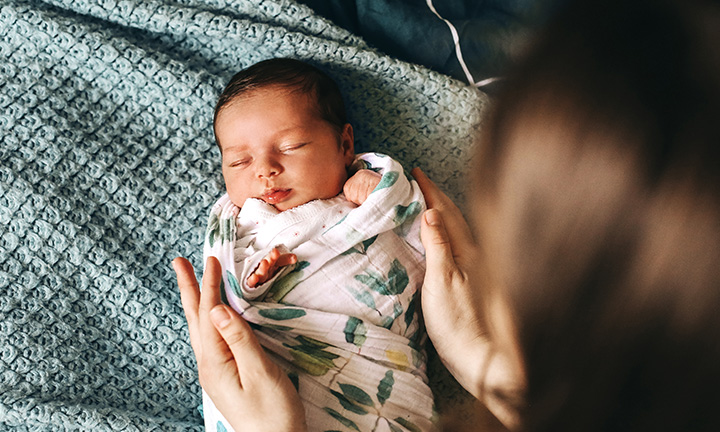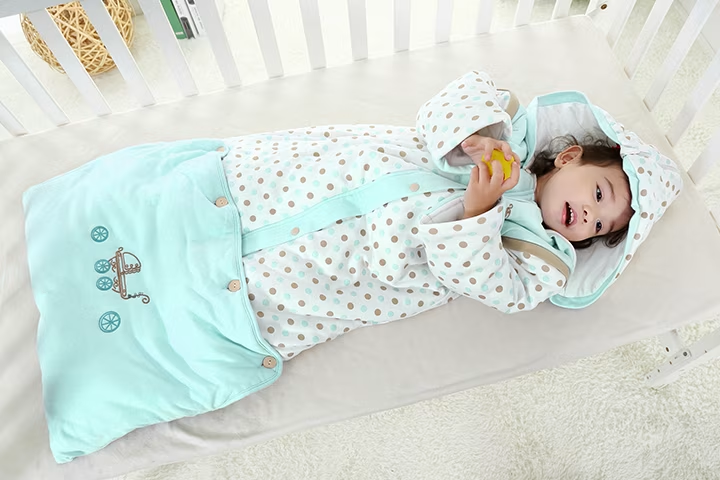
The 7 Best Baby Sleeping Sacks to Buy
Key Takeaways
Sleeping sacks are ideal for keeping your baby warm at night while still allowing her to move her arms and legs freely. They are a smart alternative to standard blankets and other forms of loose bedding, which are unsafe for your little one in the first 12 months of life.
Whether you’re looking for a wearable blanket for summer or winter, one that’s with sleeves or without, or a transitional sleeping sack swaddle to bridge the gap between the two, we’ve got you covered! More than 1,000 Pampers Parents voted for their favorite baby sleeping bags. We’ve listed 7 of the best as well as pros and cons to help you make an informed choice about which product is right for you and your baby.
What Is a Sleeping Sack?
As the name suggests, a sleeping sack (also called a wearable blanket, a blanket sleeper, or sometimes a baby sleeping bag) is essentially a bag-like garment made of a soft fabric that helps keep your baby warm during sleep. A wearable blanket isn’t constricting like a swaddle blanket, so your baby can move and kick his legs. The top half of a wearable blanket looks like a short- or long-sleeved top, so your little one’s arms can move freely. If your baby prefers to sleep with her arms above her head, or she enjoys sucking her thumb to self-soothe, a sleeping sack can give her the freedom to do this. However, not all babies enjoy being in a sleeping sack, so you may need to try one for a while to see if your little one takes to it.
Here are some of the benefits of a sleeping sack:
Although some parents prefer using a thin swaddle blanket for the newborn phase, some sleeping sacks can provide a swaddle-like hold (with the baby’s arms tucked in) and then can be modified to become more like a standard sleeping sack, where the arms are loose. Consider the Halo SleepSack Swaddle if this option sounds appealing.
For How Long Can Babies Use Sleeping Sacks?
According to experts, sleeping sacks that allow your baby to move freely can be used for as long as you and your little one like. Check the size and age limits recommended by the manufacturer and then remember to go up a size once your baby grows out of the wearable blanket. Though some sleeping sacks on our list are designed just for newborns and older babies, others also offer toddler sizes, mostly for 12- to 18-month-olds, though one — the Halo SleepSack — does work for toddlers up to 24 months old.
Are Sleeping Sacks Safe for Babies Who Can Roll Over?
Yes, sleeping sacks that allow your baby to move his arms and legs freely are safe to be used even once your baby can roll over. It’s important to note that if you are swaddling your little one or using a sleeping sack that constricts arm movements, or compresses the chest and body, it’s safest to stop doing this before your baby shows signs of being able to roll over. Constricting your little one’s movements means that she may not be able to roll back onto her back if she rolls onto her front or side during sleep. Although each baby is unique, many babies start trying to roll over when they're about 2 months old, with the strength and motor development needed for this skill taking a few more months to appear. You can read more about when babies start to roll over here. You’ll need to keep a close eye on your little one’s development and stop swaddling before he begins trying to roll over.
A Note on Safe Sleep for Your Baby
Here are some important steps to take to ensure safe sleep for your baby:
Read more about sleep safety and how to help prevent sudden infant death syndrome (SIDS).
What Should Your Baby Wear Under a Sleeping Sack?
The amount of clothing or layers your baby needs for sleep depends on the room temperature. The goal is for your baby to be comfortable — not too hot and not too cold. Consider the following guidelines when deciding what to dress your baby in and ask your baby’s healthcare provider for advice if you’re unsure:
Keep in mind that the temperature and the season might also affect the kind of wearable blanket you choose. For example, in winter you might go for a microfleece sleeping sack with sleeves, and in the summer, you might switch to a cotton sleeping sack without sleeves. Some wearable blankets are designed to be worn in different types of weather, and in this case simply adjust the layers underneath according to the room temperature.
Types of Baby Sleeping Sacks
These are some of the first basic choices you need to make when buying a sleeping sack:
What to Look for When Choosing a Baby Sleeping Sack
Beyond the basic choices outlined above, there are some important features and qualities Pampers Parents recommended considering when choosing the right sleeping sack for you and your little one:
The 7 Best Sleeping Sacks
These are the best baby sleeping sacks according to Pampers Parents:
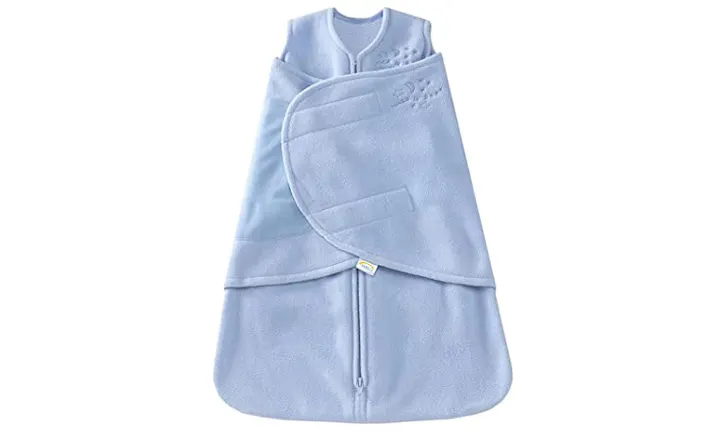
Many Pampers Parents noted its versatility, and how easy it was to transition from the swaddling mode to the sleeping sack.
I have used HALO sleeping sacks for my baby since he was a newborn (he now wears size L). I like how you can wrap the wings of the sleeping sack around one arm, two arms, or around the torso. I think this helped my baby feel warm and secure.
Pampers Parent
Wrapping the attached wing around your baby’s torso may help your baby feel more secure. The strip of hook and loop fastener provided is long so you can adjust the waist panel to your baby’s size. The product is made of 100 percent polyester microfleece, and many Pampers Parents noted how cozy this sleeping sack was even during cold winters. The manufacturer also says this product is designed for chillier weather, so if you’re looking for a sleeping sack for winter, this could be a good choice! The inverted zipper allows for easier diaper changes because you can simply open the bottom of the sleeping sack to access the diaper area. Another nice thing about this product is the wide range of sizes. In addition to the newborn and small sizes (which cover about the first six months), it also has a preemie offering.
So soft and secure. I can rest easy knowing he's warm and safe just like in my arms.
Pampers Parent
Highlights: There is no shortage of color options. Pick from pink, blue, teal, or cream, or patterns like dinosaurs, leopard spots, stripes, or even camouflage! Price*: about $21.99 on Amazon.com
Pampers Parents pros and cons:
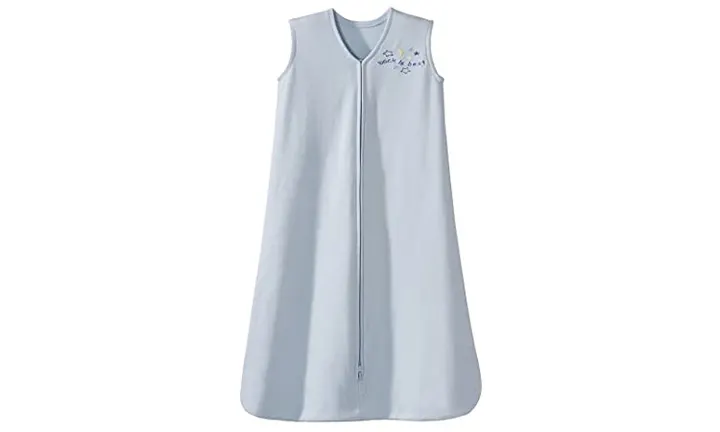
This sleeping sack is made of 100 percent cotton and is sleeveless, so one strategy is to go with the microfleece Halo sleeping sack for winter, and this cotton version for summer. Note that some Pampers Parents used this one in both summer and winter. As one Pampers Parent said, it’s light but still keeps the baby warm, especially with long-sleeved PJs or a bodysuit underneath. Several Pampers Parents mentioned that this was a great option for a sleeping bag if their newborn did not enjoy being swaddled. One possible downside is that the zipper is inverted but not two-way. In other words, it can only be opened from the bottom. This sleeping sack comes in lots of colors and patterns including stars, animals, and floral. One design even includes a “back is best” embroidery to remind everyone who cares for your little one to always place her on her back for sleep. Another plus is that the product comes in small, medium, large, and extra large. The extra large accommodates toddlers from 18 to 24 months, and this is unusual, as most sleeping sacks are designed for use up to 18 months at most. If you’d like to continue giving your toddler a wearable blanket to sleep in as she nears 2 years of age, then this product could be the way to go!
My girls didn’t like having their arms tucked in (even as newborns) so giving their arms mobility was a big feature. I also liked that I could layer them up as much or as little as I needed to depending on the season. That made these sleeping sacks versatile for both my summer and winter babies. The reverse zipper was also a huge perk for those nighttime changes!
Pampers Parent
Highlight: The inverted zipper allows for easier diaper changes because you can open up the sleeping sack from below. Price*: about $19,99 on Amazon.com
Pampers Parents pros and cons:
3. Carter's Baby Microfleece Sleepbag
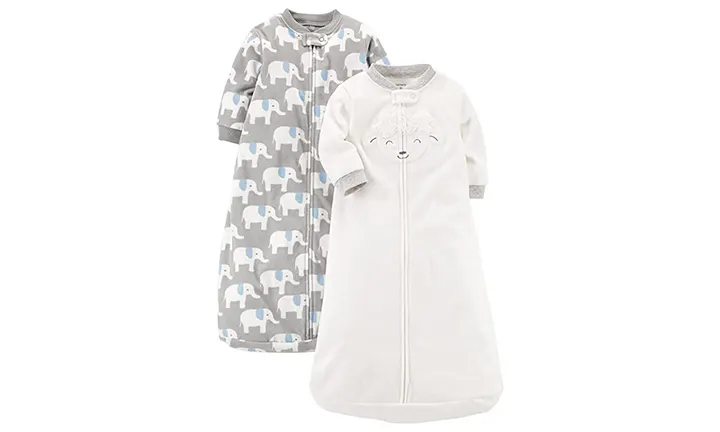
Why pick this one? This sleep bag is made of 100 percent polyester microfleece to keep your baby warm. It has sleeves, so this sleeping sack is definitely an option more suitable for winter. One Pampers Parent noted and appreciated that the sleeves were not so restrictive that their baby couldn’t self-soothe by sucking her thumb. This sleeping sack has an inverted zipper, for easier diaper changes. The top of the zipper is covered in a little fabric for your baby’s comfort. This is a traditional sleeping sack with no extra bells and whistles, but if you’re looking for a basic model then this could be a great option.
They have a little wiggle so my baby could grow into it. That's also great because even when a baby is stretching out they don't get fussy because they can't stretch! The fabric is super soft and wasn't irritating to my baby's sensitive skin. The long sleeves kept her super cozy and even in summer she never got too hot, although we did have sleeveless cotton ones for really humid nights.
Pampers Parent
Highlights: A big plus of this product is that there are two in a pack, and you’ll love the cute elephant and sheep designs. Price*: about $17.31 on Amazon.com
Pampers Parents pros and cons:
4. Burt's Bees Baby Sleeping Sack
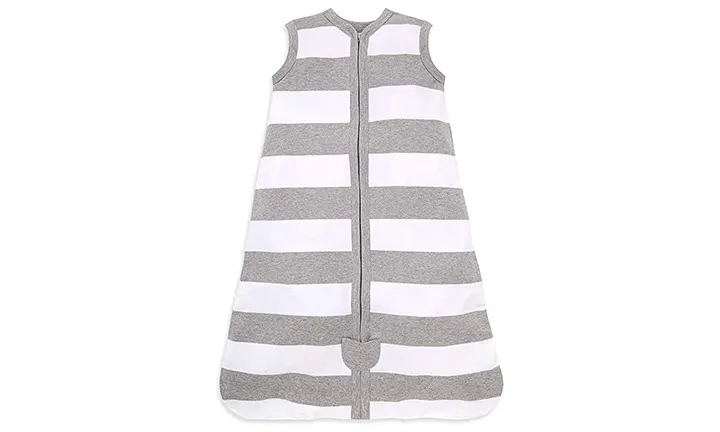
Why pick this one? Made of 100 percent organic cotton, this simple sleeping sack has a few thoughtful extra features you’ll really love. It has a two-way zipper so you can open it from both the bottom and the top. When closed the zip is hidden behind fabric so your little one’s fingers won’t get caught or scratched. The end of the zipper is covered by a pocket or a tab so that your baby can’t start unzipping himself. The manufacturer claims the sack is extra long so your baby’s legs have all the room they need. This lightweight and breathable sleeping sack could be great for the warmer months, but Burt’s Bees also offers a medium-weight version for the cooler months. It comes in small, medium, and large, covering newborns to 18-month-olds.
This is our favorite sleeping sack for summer. It’s lightweight and soft. We love that it has an inverted zipper for easy middle-of-the-night diaper changes.
Pampers Parent
Highlight: The color and print options are probably the most modern of all the sleeping sacks on this list. There’s a gorgeous blue moon design, black stars, pink florals, and a bee design with the alphabet on it. Price*: about $17.94 on Amazon.com
Pampers Parents pros and cons:
5. Amazing Baby Muslin Sleeping Sack
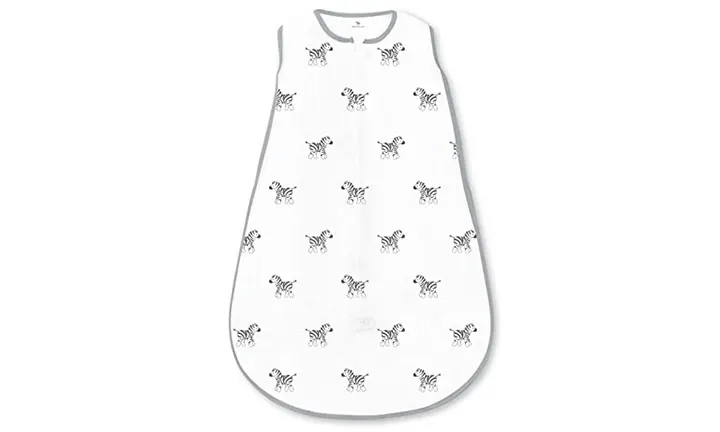
Why pick this one? Coming in fifth on our list is this breathable, open weave cotton muslin wearable blanket. The open weave airy fabric could be ideal for the summer months. Advantages of the two-way zipper, according to the manufacturer, are that the bottom zipper makes diaper changes easier and the top zipper makes it easier to put your baby into the sleeping sack. The top zipper is covered by fabric to prevent your little one’s chin from getting scratched, and the bottom zipper is covered by a flap of fabric so that your baby can’t accidentally start unzipping herself. It comes in small, medium, and large, which covers newborns to 18-month-olds.
I had a summer baby, and this was perfect for naps/nighttime. Not too heavy. He slept so comfortably in just this sleeping sack and a bodysuit!
Pampers Parent
Price*: about $16.84 on Amazon.com
Pampers Parents pros and cons:
6. Amazing Baby Transitional Swaddle Sack
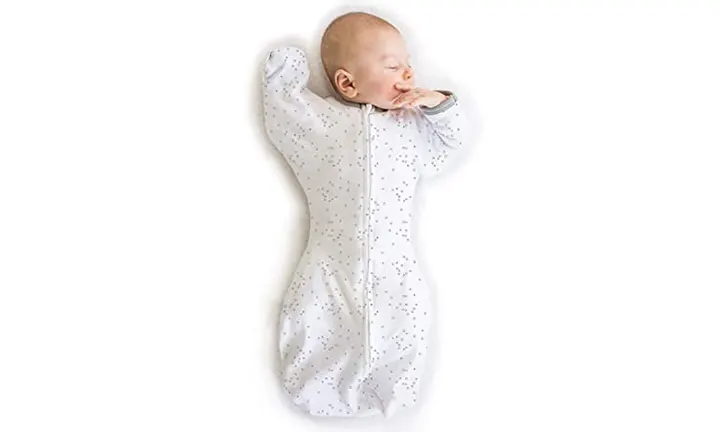
The manufacturer claims that having the cuffs closed somewhat restricts the startle response (also known as the Moro reflex) and that this may reduce the likelihood of your baby waking himself up from the jerking movement. You can read more about your baby’s reflexes here. Having the cuffs folded over can also help prevent your baby scratching his delicate skin during the night. Once your baby is ready for the complete sleeping sack experience, you can simply open the cuffs up and your baby’s hands and arms will be free. You may wish to transition slowly by opening just one cuff at a time. One Pampers Parent noted that her little girl liked to sleep with her hands above her head, and this sleeping sack accommodated that position. Made of breathable cotton, this is the kind of sleeping sack that might be good in spring and fall when the weather is variable. A potential drawback of this product is that it only comes in small and medium sizes, meaning it will only work for the first six months of your baby’s life. If you have an older baby or a toddler, you’ll need to choose another product.
It was just snug enough to help my baby still feel swaddled while learning how to sleep with his arms out, and he was able to move around in when he learned to roll over. He never seemed hot in it while wearing his long sleeve pajamas under it either.
Pampers Parent
Price*: about $19.99 on Amazon.com
Pampers Parents pros and cons:
7. Simple Joys Cotton Sleeveless Sleepbag
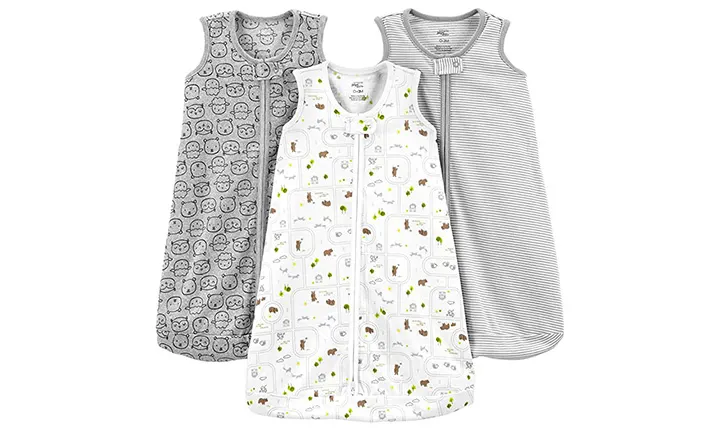
Why pick this one? Last but certainly not least, this sleeping sack offers a blanket-like layer without being too heavy, according to Pampers Parents. It’s made of 100 percent polyester, doesn’t have sleeves, has a two-way zipper, and has a zipper cover to protect your baby’s chin from scratches. At almost $30 this is the priciest product on our list, but you get 3 sleeping sacks for this price so overall this set is the best value for money. The prints are lovely, and each sleeping sack in the multi-pack is unique. The largest size only works for babies up to 9 months, so if your baby is any older than that then this product probably won’t work for you.
This sleep bag is lightweight and great for layering. It’s easy to put on and take off. And, it holds up well after many washes.
Pampers Parent
Price*: about $27 on Amazon.com
Pampers Parents pros and cons:
The Bottom Line
Now that you know what options you have when it comes to choosing a sleeping sack, and which products are Pampers Parents favorites, we hope making a decision about which way to go is a little easier! All of these sleeping sacks are great options, and you may well find you’ll choose one brand for summer and another for winter. Either way your baby will be as snug as a bug and very cute in her little sleeping sack.
Recall Notice
Before buying a product, always check that it’s approved and hasn’t been recalled on sites like the Juvenile Products Manufacturers Association and the U.S. Consumer Product Safety Commission (CPSC).
*Prices are correct at the time of writing.
Read more about Best Baby Products
Related Articles
Join a World of Support
through Pregnancy and Parenthood.
TRACK WITH TOOLS
LEARN WITH EXPERTS
GET REWARDED





